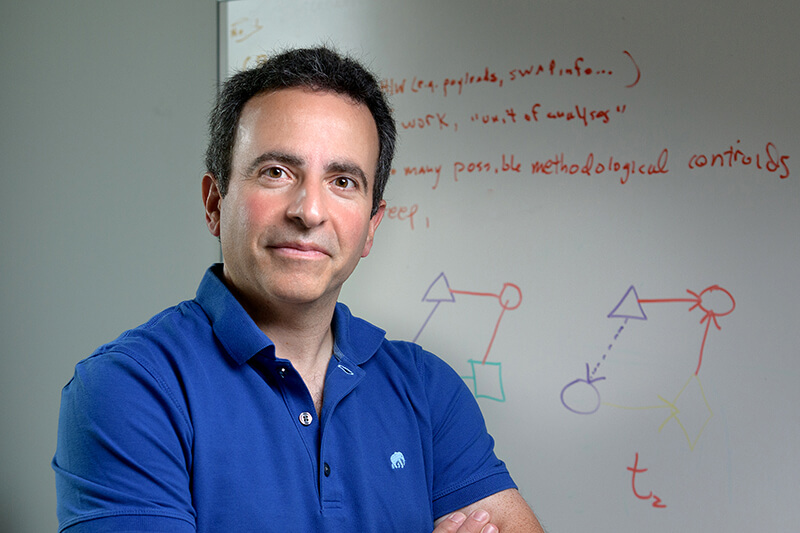
Daniel DeLaurentis, a professor of aeronautics and astronautics and director of Purdue's Institute for Global Security and Defense Innovation, researches the systems of the fastest hypersonic aircraft and slowest package delivery drones, working to get the aircraft systems to work together. (Purdue University photo/John Underwood)
Aerospace engineer enjoys challenge of uniting aviation operating systems
WEST LAFAYETTE, Ind. — Hypersonic aircraft offers travelers a velocity at five times the speed of sound or faster. Smaller vertical-lift craft are much slower but could be tasked with package delivery. The two kinds of aircraft couldn't sound more different.
But for Purdue University's Daniel DeLaurentis, his research into both is remarkably similar, getting the independent internal and external systems within an aircraft to work together in concert, creating a system of systems.
"While the physics and challenges are very different when designing hypersonics aircraft versus vertical take-off ones, the underlying concept I examine is the same," he said. "How do you create the optimal system design that accomplishes the aircraft's mission using the knowledge not only of the aerodynamics and control but also the economics for that particular vehicle."
DeLaurentis, a professor of aeronautics and astronautics, develops new effective methods, theories and tools for systems of systems, specifically in aerospace, in situations where the factors involved are dramatically varied and diverse. One example is designing aircraft that can fly reliably at hypersonic speeds but also withstand the turbulent air and intense heat created by flying at six times the speed of sound (more than 4,000 mph) or faster.
DeLaurentis also is director of Purdue's Institute for Global Security and Defense Innovation, where he works to network and integrate Purdue research teams and systematically connect them to the most pressing defense and security needs.
System of systems research brings with it a new level of difficulty because of the diversity of the factors involved. DeLaurentis said he wants to do more than simply create a basic solution.
"I don't want to spend a lot of time solving a problem that's not the right problem to solve," he said. "It doesn't mean that solving the small-scale problems aren't important, but for me, I enjoy the challenge of continually testing what is the higher-level problem to be formulated and solved."
That challenge involves working on several projects related to hypersonics. DeLaurentis also is focused on three projects related to the new area of urban air mobility and automated freight-package delivery.
His research is not restricted only to aerospace. For example, DeLaurentis has done projects with John Deere where he enjoyed exploring the systems problem of determining the integration precision necessary between equipment, seed, soil and fertilizer.
System of systems challenges fall beyond engineering as well for DeLaurentis, whose early research on supersonic commercial transport design bolstered his interest toward system of systems.
Part of the system of systems problem-solving involves expressing opposing factors mathematically. Tackling the air transportation system is such an example.
"My research emphasizes really formulating the problems and understanding how to express components mathematically because, in the air transportation system, for example, aerodynamics are important, but airline economics also are important," DeLaurentis said. "So how do you put those two things together in an equation?
"Some days, all those work well; others they don't," he said. "How all those different facets involved interplay is part of the system of systems design problem."
Through DeLaurentis time at i-GSDI, Purdue has more tightly integrated one of the most comprehensive hypersonics research capabilities in the country, with nearly 40 world-renowned researchers in hypersonics and expertise in navigation, aerodynamics, aerothermal effects propulsion, autonomy, system engineering, high-temperature materials, and manufacturing. Earlier in fiscal year 2020, Purdue was awarded an Air Force contract to develop the first quiet Mach 8 wind tunnel in the world.
In July 2019, Purdue hosted the inaugural NDIA Hypersonics Capabilities Conference, which brought military, government, congressional, industry and policy leaders to further advance U.S. hypersonic systems. Purdue and Johns Hopkins Applied Physics Laboratory recently signed an agreement to collaborate on hypersonic research and related technologies. This occurs as the Purdue relationship with Sandia National Laboratories, with a key emphasis in hypersonics and cyber security, enters its fifth year.






